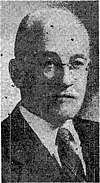Frank Lauren Hitchcock
| Frank Lauren Hitchcock | |
|---|---|

Frank Lauren Hitchcock (1875–1957)
|
|
| Born | March 6, 1875 New York City, United States |
| Died |
May 31, 1957 (aged 82) Los Angeles, United States |
| Residence | United States |
| Nationality | American |
| Fields | Chemistry and Mathematics |
| Institutions |
Massachusetts Institute of Technology North Dakota State University |
| Alma mater |
Harvard University Phillips Andover Academy |
| Doctoral students |
Gleason Kenrick Claude Shannon |
| Known for | Transportation problem |
Frank Lauren Hitchcock (March 6, 1875 – May 31, 1957) was an American mathematician and physicist known for his formulation of the transportation problem in 1941.
Frank did his preparatory study at Phillips Andover Academy. He entered Harvard University and completed his bachelor's degree in 1896. Then he began teaching, first in Paris and at Kenyon College in Gambier, Ohio. From 1904 to 1906 he taught chemistry at North Dakota State University, Fargo.
Hitchcock returned to Massachusetts and began to teach at Massachusetts Institute of Technology and study at the graduate level at Harvard. In 1910 he obtained a Ph.D. with a thesis entitled, Vector Functions of a Point. Hitchcock stayed at MIT until retirement, publishing his analysis of optimal distribution in 1941.
Frank Hitchcock was descended from New England forebears. His mother was Susan Ida Porter (b. January 1, 1848, Middlebury, Vermont) and his father was Elisha Pike Hitchcock. His parents married on June 27, 1866. Frank was born March 6, 1875, in New York City.
He had two sisters, Mary E. Hitchcock and Viola M. Hitchcock, and two brothers, George P. Hitchcock and Ernest Van Ness Hitchcock. Although Frank was born in New York City, he was raised in Pittsford, Vermont.
...
Wikipedia
